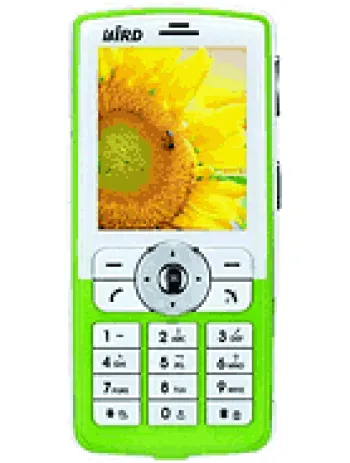
Overview and History
The Bird S699 is a feature phone that surfaced in the mid-2000s, specifically announced during the third quarter of 2005. Though it was subsequently cancelled and never saw commercial release, the S699 generated interest as part of a wave of mobile devices during a period characterized by rapid technological advancements in mobile communication. As a feature phone, it was designed for essential communication functions rather than the multimedia and internet features that would become common in later years.
Design and Build
With dimensions measuring 104.3 x 44 x 15.7 mm (4.11 x 1.73 x 0.62 in), the Bird S699 had a compact and lightweight build typical of early 2000s handsets. The device was designed to be ergonomically friendly, offering users ease of handling with its Mini-SIM compatibility. While the phone's exact weight isn't listed, consumers of the era generally favored devices that were easy to carry and fit comfortably in a pocket.
The S699 was released in a classic black color, an aesthetic choice that provided a professional and timeless look, appealing to various user demographics at the time. Its straightforward design emphasized function over form, in line with many devices of that era.
Display Features
The Bird S699 featured a CSTN display capable of rendering 65K colors, with a resolution of 120 x 128 pixels. This type of display was common in earlier phone models, preceding the widespread adoption of more advanced technologies like TFT and OLED screens. The relatively low resolution, by today's standards, was sufficient for displaying simple graphics, basic user interfaces, and text.
Network and Connectivity
The phone supported GSM technology, operating on the 900/1800 bands, which made it suitable for basic voice and text communication in various regions, notably those using these frequencies. However, the device did not support GPRS or EDGE, limiting it to voice and SMS services. Absent from the Bird S699's connectivity options were modern features such as WLAN, Bluetooth, and USB, reflecting its design focus on fundamental telecommunication functions rather than data connectivity.
Memory and Storage
With no capability for expandable storage via a card slot, the Bird S699's memory provisions were limited to facilitating basic features. The phone's capacity to store up to 100 phonebook entries and maintain records of recent call activity (20 dialed, 20 received, and 20 missed calls) met essential user needs in the management of contacts and communication history.
Audio and Sound
Audio output on the Bird S699 was limited to vibration and polyphonic ringtones, with no loudspeaker or 3.5mm jack options available. While the device might seem lacking in audio variety by today's standards, polyphonic ringtones were popular at the time for offering more melodic alert tones. The absence of a headphone jack indicated an emphasis on simplicity and the mobile's focus on telecommunication rather than media consumption.
Battery Life and Charging
Equipped with a removable Li-Ion battery, the Bird S699 promised a standby time of up to 75 hours and a talk time of up to 2 hours. During the period, such battery life was adequate for users whose primary use was call and text-based. The removable battery also meant users could carry spares or replace fading batteries, a convenience that has largely been replaced by today’s direct battery integration.
Software and Features
The Bird S699 operated as a feature phone, which typically means limited functionality beyond calling and texting. Messaging capabilities were confined to SMS, with no support for multimedia or internet-based messaging services. As was standard with many phones of its kind, two embedded games were available as a form of entertainment. However, the phone did not support Java, limiting possibilities for additional applications or enhanced interactivity.
Market Context and Conclusion
Despite being cancelled, the Bird S699 represents a segment of early mobile phones designed to provide essential connectivity in a compact, user-friendly format. During its announcement era, phones like the S699 catered to users who prioritized communication over the technological complexities and multimedia capabilities now prevalent in modern smartphones. The cancellation of the Bird S699 may stem from shifting market dynamics as consumer desires veered toward devices with broader, more integrated functionalities.
Overall, the Bird S699 illustrates how far mobile technology has evolved, from devices where simplicity was key, to today’s multifunctional smart devices. While it remains a footnote in mobile history, understanding such devices provides valuable insights into user needs and industry trends across different technological generations.
Main Features of Bird S699
- Compact dimensions: 104.3 x 44 x 15.7 mm
- Supports GSM 900 / 1800 bands
- CSTN display with 65K colors
- Resolution of 120 x 128 pixels
- Phonebook capacity of 100 entries
- Call records for 20 dialed, 20 received, and 20 missed calls
- Polyphonic ringtones with vibration alert
- Two embedded games
- Removable Li-Ion battery
- Stand-by time up to 75 hours
- Talk time up to 2 hours
- Classic black color design
Key Disadvantages of Bird S699
- Lacks advanced network technology beyond GSM; no 3G or 4G support.
- No GPRS or EDGE for data connectivity.
- Device was announced but later cancelled, never released to market.
- Display uses outdated CSTN technology with limited 65K colors.
- Very low screen resolution of 120 x 128 pixels.
- No memory card slot for storage expansion.
- No camera functionality available.
- Does not include a loudspeaker or 3.5mm headphone jack.
- No Bluetooth, WLAN, or any form of wireless connectivity.
- No radio or USB connectivity options.
- Limited messaging capabilities, only supports SMS.
- No support for Java applications.
- Short battery life with up to 75 hours standby and only 2 hours talk time.

View Also
More Phones
All Rights Reserved +14267 Phones © Mobilawy 2025

























